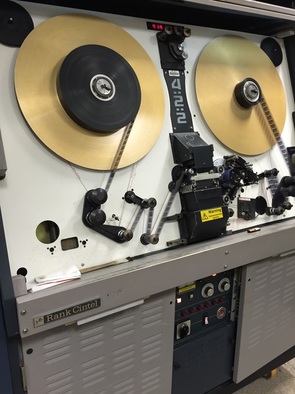Friday 14 August 2015, and Amara and Ian from UCL visit BBC S&PP DMS at our base in South Ruislip with four neatly tied boxes containing Gerald Lankester Harding's 9.5mm film collection which we have been commissioned to digitise. After introductions and over mugs of tea we discuss the subject of the films, the equipment and processes involved in their digitisation, and the form of the deliverables at the end of the process.
Shortly afterwards, I settle down to begin my inspection and preparation of the Harding films to make them ready to run on our Cintel Mk3 flying-spot Digiscan telecine, specially modified in-house to handle 9.5mm film.
 Photo: I. Carroll, 2015.
Photo: I. Carroll, 2015. As I wind the film through my fingers I feel for any splices or damage such as torn perforations. Splices in films of this age from the 1930s almost always need attention; any that I find I check for correct registration and reinforce with the CIR tape splicer. After 80-odd years the original film cement becomes brittle and the action of the telecine machine, although much more gentle than a projector, will certainly find the weak splices. Similarly, any tears or damaged perforations are patched with splicing tape. A quick squint through a lupe eyeglass to check that the images are the correct way round and then I reach the end of the first cartridge.
I either cut or detach the end of the film from the spindle and the usual problem with 9.5mm films that have been stored in their original cartridges for many years becomes apparent – the inner turns have been wound up tightly on such a small diameter spindle for so long that they have the curliness of a watchspring and just want to coil up in a tangle. Having sorted out the tangle I manage to attach a short length of white spacing film to the end which calms things down a bit and move on to the next cartridge and repeat the process, adding successive films with white spacing between until the large spool is full. Onto each length of spacing I write the next film’s reference number so that they can all be identified to avoid any confusion. Another length of white spacing on the end and films 'LH1' to 'LH18' are joined up and ready for cleaning.
Cleansing of films such as these is done by hand and involves winding the film slowly through a folded Selvyt cloth moistened with Isopropanol. A pause every so often to remoisten the cloth and see how much dirt has been removed and if it looks spectacularly filthy I give the reel a second pass - which turns out to be required for the Harding films. Once the large first reel is cleaned I start on the remainder of the cartridges. In due course, taking time to refocus my eyes, films 'LH19' to 'LH46' are duly inspected, mended and cleaned.
Although I haven’t studied the images closely at this point, during all the winding and inspection it became apparent that the collection is the result of several different cameras and some of the individual cartridges are compilations edited together from different sources on different film stocks, although all in black-and-white. Two of the cartridges turn out to be commercial printed films – the “home entertainment” of the 1920s and 30s. These incorporate Pathe’s “notched titles” feature, where a notch cut in the edge of the film would cause the projector’s transport to stop for a few seconds before moving on. Used for freezing static shots or titles and captions this was a cunning way of extending the screen time of films which otherwise might only run for 1½ minutes from a small 10-metre cartridge. With time, as projectors got brighter and lamps got hotter the system had to be dropped since the risk of burning stationary film in the gate became too great.
In a perfect world, once cleaned it is best practice to leave 9.5mm material like this which has come out of its original cartridges wound up tightly on a large-diameter spool or film core for as long as possible to “rest” and persuade the extreme curliness to relax. Not doing so can cause loss of focus during transfer towards the end of individual films when the curl is so strong that the film refuses to lie flat in the telecine gate. This time to rest is a luxury we don’t always have when jobs come in with tight deadlines but in this case Amara and Ian are in no hurry and I am able to leave the Harding films wound up on two large reels safely stored in cans in our secure and temperature-controlled vault, waiting for the next stage of the process – the telecine transfer itself.
To be continued…
 RSS Feed
RSS Feed

